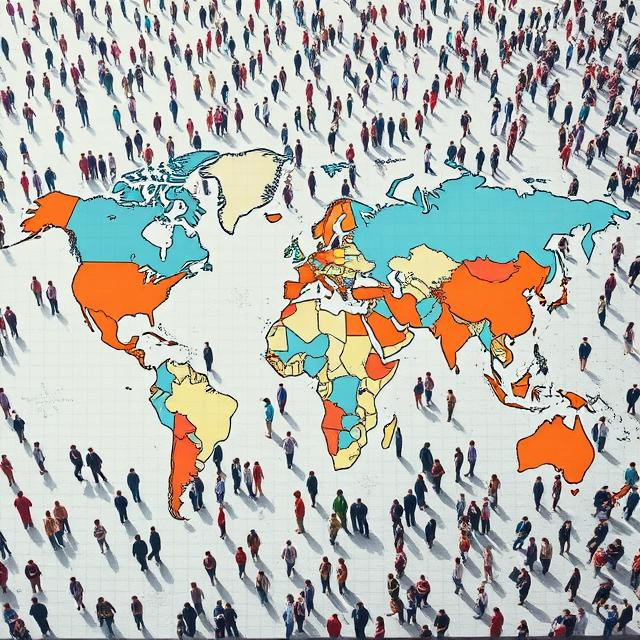The world population is a dynamic entity, constantly changing and evolving influenced by various factors such as birth rates, death rates, immigration, and socio-economic conditions. As of recent estimates, the global population stands at approximately 8 billion people, which brings forth a range of challenges and opportunities. Understanding the world population’s growth trends, particularly where significant changes occur, is crucial for developing effective policies and addressing pressing global issues. In this article, we will explore the current state, historical growth, and future projections of the world population, as well as the implications of this growth for sustainability and climate change.

Overview of the Current World Population: Facts and Figures
As of 2023, the world population is approximately 8 billion, a number that continues to grow every year. This growth is not uniform; different regions experience varying rates of increase, reflecting cultural, economic, and social factors. For instance, countries in Africa and parts of Asia are seeing rapid population growth due to higher birth rates and decreasing mortality rates. In contrast, many Western countries face stagnation or decline in population, leading to concerns about aging populations and workforce shortages. Understanding these dynamics is crucial for policy-makers and planners who need to allocate resources effectively and anticipate future challenges, such as housing, education, and health care.
Historical Growth of the World Population: Key Milestones
The world population has a fascinating history characterized by significant milestones. In 1804, the global population reached 1 billion for the first time, which was a landmark moment in human history. The pace of growth accelerated dramatically with the advent of the Industrial Revolution and improvements in medicine and agriculture, allowing the population to reach 2 billion by 1927. The post-World War II baby boom further exacerbated this growth, and by 1974, the population had hit 4 billion. This trend continued, driven by advancements in health care and food production, leading to the current figure of 8 billion in 2023. These milestones illustrate that population growth is closely tied to human development and technological progress and pose both opportunities and challenges.
Regional Breakdown: Where Are People Concentrated in the World?
Population distribution is uneven across the globe, with certain regions being far more densely populated than others. For example, Asia is home to 60% of the global population, with China and India alone accounting for over a third. Africa is also witnessing significant growth, particularly in countries like Nigeria and Ethiopia. Conversely, regions like Europe are experiencing population decline due to low birth rates and high emigration rates. Understanding where people are concentrated helps in urban planning, resource allocation, and infrastructure development. It also highlights areas that may require international support to address the challenges posed by rapid population increases, such as healthcare and education.
Factors Influencing World Population Growth: Birth Rates and Mortality Rates
Several factors significantly influence population growth, with birth rates and mortality rates being the most critical. Countries with high birth rates often correlate with limited access to education and family planning resources, particularly for women. Conversely, lower mortality rates due to advancements in health care and sanitation can lead to population surges. In many developing nations, higher fertility rates persist despite decreasing mortality rates, leading to rapid population growth. Meanwhile, developed countries often experience lower birth rates and higher life expectancies, which can lead to aging populations. Understanding these demographic factors is essential for developing targeted interventions and policies to manage population growth sustainably.
Urbanization and Its Impact on Global Population Distribution
Urbanization plays a crucial role in how the world population is distributed. As people move from rural to urban areas in search of better opportunities, cities expand and develop into megacities. Currently, more than half of the world’s population resides in urban areas, a trend that is expected to continue. This shift has significant implications for resource allocation, infrastructure development, and social services. Urban areas can offer more job opportunities, but they also face challenges such as overcrowding, pollution, and inadequate infrastructure. Addressing these issues will be crucial in managing sustainable urban growth in the face of increasing world population pressures.
Challenges Posed by Rapid Population Growth: Resources and Sustainability
Rapid population growth presents numerous challenges related to resource scarcity and sustainability. As the world population continues to climb, the demand for food, water, and energy grows exponentially. This can lead to overexploitation of natural resources, environmental degradation, and increased pollution. Countries must find ways to balance population growth with sustainable practices to ensure that future generations have access to the resources they need. Additionally, governments and organizations must adopt innovative strategies to manage urbanization and its associated challenges, from housing to healthcare, while maintaining a commitment to sustainability and environmental stewardship.
The Role of Technology in Managing World Population Data
In today’s data-driven world, technology plays a vital role in managing and understanding world population trends. Advanced data analytics, geographic information systems (GIS), and remote sensing technologies enable researchers and policymakers to visualize and analyze population dynamics in real time. This data is crucial for informed decision-making related to urban planning, public health, and socio-economic development. Furthermore, technology can enhance global cooperation by sharing data and best practices among countries to address common challenges posed by population growth. The integration of technology with population studies can result in more effective and targeted strategies.
Future Projections: What Will the World Population Look Like in 2050?
Looking ahead, projections indicate that the world population could reach approximately 9.7 billion by 2050. Most of the growth is expected to occur in developing countries, particularly in Africa and parts of Asia. This growth will present unique challenges, including increased demand for food, water, and healthcare services. Policymakers will need to implement comprehensive strategies that involve education, healthcare access, and family planning to mitigate the consequences of unchecked growth. The patterns observed now may evolve as new technologies and social changes reshape our world, thus making future predictions uncertain and necessitating adaptive strategies.
The Interconnection of Climate Change and World Population Trends
Climate change is fundamentally linked to world population trends, as more people tend to generate higher greenhouse gas emissions and environmental impacts. Increased demands for energy, water, and food resources, driven by population growth, contribute to environmental degradation. Conversely, climate change can also affect population trends, leading to displacement due to natural disasters and altering habitable areas. Addressing these interconnected issues requires a multifaceted approach that includes promoting sustainable practices, adopting cleaner technologies, and implementing policies that consider both population dynamics and environmental stewardship. Failure to address these complexities may exacerbate existing challenges.

Policy Solutions for Sustainable Population Growth: Insights from Around the Globe
A range of policy solutions can be employed to manage world population growth sustainably. Initiatives that promote education, particularly for women, and access to reproductive health services play a critical role in controlling birth rates. Countries like Bangladesh have made significant strides by implementing community-based family planning programs that have empowered women and improved economic conditions. Additionally, investments in sustainable agriculture and renewable energy can mitigate the resource pressures caused by population growth. International cooperation is essential in sharing successful practices and strategies, ensuring that all nations can benefit from and contribute to sustainable population management.
Conclusion
The current state of the world population presents numerous opportunities and challenges. Understanding the dynamics of population growth, its historical context, and future projections is essential for policymakers, researchers, and global citizens alike. As we navigate these complexities, it’s crucial to incorporate sustainable practices that address the needs of growing populations while safeguarding the planet’s resources. By harnessing technology, promoting education, and fostering international cooperation, we can create a better future, ensuring that the world population can coexist harmoniously with its environment for generations to come.
FAQs
What is the current world population?**
– As of 2023, the world population is approximately 8 billion.
How has the world population changed over the years?**
– The world population has seen significant growth since the early 19th century, reaching 1 billion in 1804 and evolving to 8 billion by 2023.
Which regions have the highest population density?**
– Asia, particularly countries like China and India, has the highest concentration of the world population, while regions like Europe often face population decline.
What factors influence population growth?**
– Key factors include birth rates, mortality rates, immigration patterns, and socio-economic development.
How does urbanization affect population distribution?**
– Urbanization leads to increased population concentrations in cities, which can create challenges like overcrowding and inadequate infrastructure.
What are the challenges of rapid population growth?**
– Rapid growth can result in resource scarcity, environmental degradation, and increased pressure on public services.
How is technology used to manage population data?**
– Advanced data analytics and GIS help visualize and analyze population trends, aiding policymakers in decision-making.
What are future population projections?**
– It is projected that the world population could reach around 9.7 billion by 2050, primarily in developing countries.
How is climate change related to population trends?**
– Population growth increases resource demands, contributing to climate change, while also causing displacement.
What policy solutions exist for sustainable population growth?**
– Solutions include promoting education, improving healthcare access, and adopting sustainable agricultural practices.